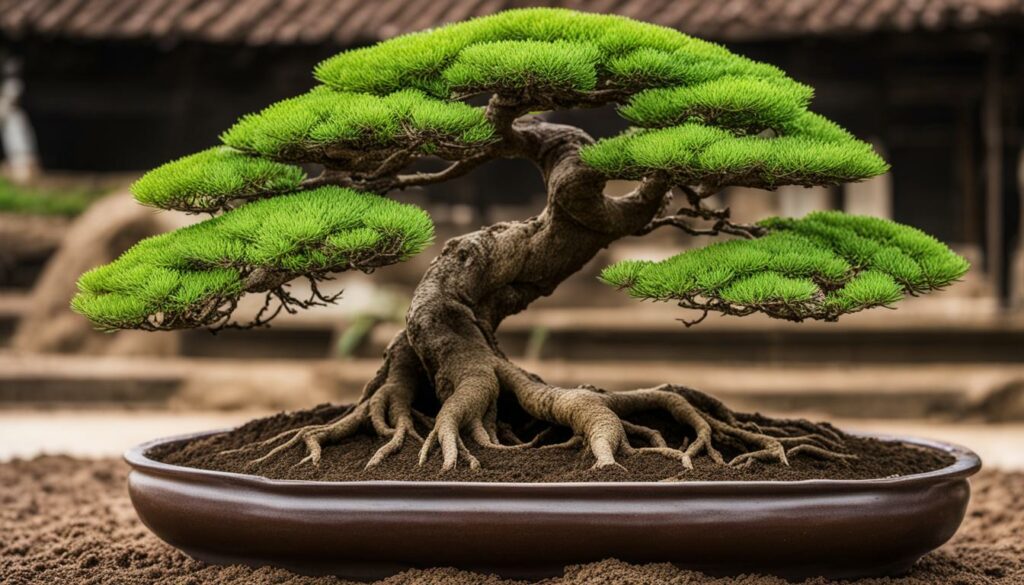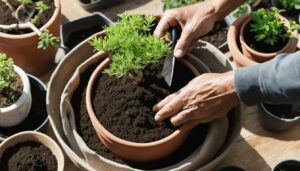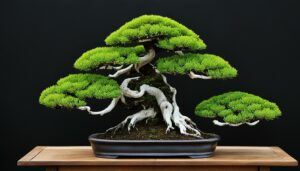Welcome to this comprehensive guide on bonsai cultivation root training and management. In this article, we will explore essential techniques for optimizing the growth and beauty of your miniature trees by focusing on the health and vigor of the root system.
Bonsai trees are a unique and delicate form of cultivation that require consistent care and attention. Root training and management play a critical role in the overall health and longevity of bonsai trees. By understanding the importance of root care, evaluating your bonsai root system, selecting the right bonsai pot, and implementing root pruning techniques, you can enhance the aesthetic appeal and vigor of your bonsai tree, resulting in a beautiful and healthy plant.
Key Takeaways
- Bonsai cultivation requires diligent root training and management for optimal growth.
- Proper root care and maintenance are essential for the overall health and longevity of bonsai trees.
- Bonsai pots play a critical role in root growth and expansion, and selecting the right pot is crucial.
- Root pruning, root styling, and suitable soil composition are additional techniques that can enhance bonsai root health.
- Regular inspection and maintenance of bonsai roots, disease prevention, and root protection during extreme weather conditions contribute to overall root health and vitality.
Understanding the Importance of Root Care
In bonsai cultivation, root care is crucial to ensure the health, stability, and longevity of your miniaturized trees. The root system of a bonsai is responsible for the absorption of water and nutrients essential for the tree’s growth. Neglecting root care can lead to root rot, which can ultimately result in the death of the tree.
By focusing on root care, you can prevent potential issues and create an optimal environment for your bonsai to thrive. Proper root care will lead to a strong and well-established root system, which in turn supports healthy foliage growth and beautiful aesthetics.
Root care involves various techniques, including root pruning, root styling, and soil composition, which we will delve into in later sections of this guide. Before exploring these techniques, let us first understand the importance of maintaining a healthy bonsai root system.
Evaluating Your Bonsai Root System
Assessing the condition of your bonsai root system is a crucial first step for effective root management. Examining the root color, density, and distribution will provide insight into the health and growth patterns of your miniature tree’s root network.
Root color: Normal root color should be light in color, ranging from creamy white to tan or light brown. Discoloration or darkening may indicate root deterioration or disease.
Root density: Proper root density ensures that the tree has a strong foundation and can acquire sufficient water and nutrients. Overly dense roots may indicate crowding or root-bound conditions, whereas sparse root growth may indicate poor health or root rot.
Root distribution: The root system should be spread evenly throughout the soil, with no large clumps or tangles. A uniform root distribution ensures even water and nutrient uptake and prevents drainage issues.
When evaluating your bonsai root system, take note of any abnormalities or concerns, such as discoloration, tangling, or poor distribution. This information will inform your root training and management decisions, allowing you to tailor your approach to the unique needs of your bonsai tree.
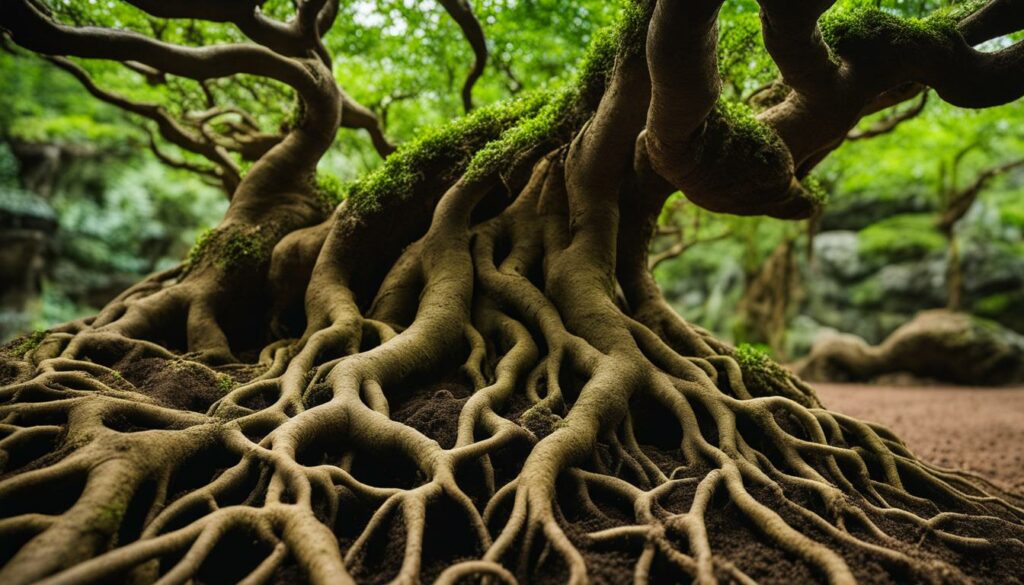
Bonsai Root System Evaluation:
| Aspect | Ideal | Concerns |
|---|---|---|
| Root Color | Light (cream, tan, or light brown) | Darkening or discoloration |
| Root Density | Even and proportionate | Overcrowding or sparse growth |
| Root Distribution | Uniformly spread | Clumping, tangling, or poor distribution |
Selecting the Right Bonsai Pot for Optimal Root Growth
Choosing the right bonsai pot is crucial for promoting healthy root growth. Consider the following factors:
- Size: Make sure the pot is the appropriate size for your bonsai tree. It should be large enough to accommodate the roots, but not so big that it hinders growth or stability.
- Material: Pots can be made from various materials, such as plastic, ceramic, or clay. The material you choose can affect watering needs and root temperature, so choose wisely.
- Drainage: Look for pots with ample drainage holes to prevent water buildup and root rot.
- Shape: Consider the shape of the pot, as it can affect the overall aesthetic and balance of the bonsai tree.
When repotting, make sure to trim any circling roots to encourage outward growth. Additionally, consider using a soil mix that promotes optimal root health and drainage.
Root Pruning Techniques for Bonsai
Root pruning is an essential element of bonsai cultivation that involves cutting off a portion of the root system, enabling the plant to develop new feeder roots. Pruning the roots also helps to maintain a root-to-shoot ratio, essential for the plant’s overall health.
Timing is crucial when it comes to root pruning. Generally, bonsai growers prune roots every two to three years, although those with fast-growing species may need to prune annually. Spring and autumn are the best time for root pruning, as the plant is in the growth phase, which enables it to heal more quickly.
Step-by-Step Guide for Root Pruning:
- Carefully lift the plant out of its pot and untangle the roots using a root hook or chopstick
- Trim back the long roots that protrude from the root ball, leaving the smaller, finer roots intact
- To create a new root system, cut away one-third of the roots, ensuring that you don’t cut too close to the trunk
- After pruning, refresh the soil mixture and repot the plant
- Water it thoroughly and let it drain evenly
Root pruning encourages the development of finer feeder roots that aid in better nutrient uptake. Always ensure that you don’t prune too excessively, or it may result in root death.
Expert Tip: If your bonsai has been over-watered or has yellowing leaves, it may be time to consider root pruning. Pruning your roots can help to reverse some of the damage and promote new healthy growth.
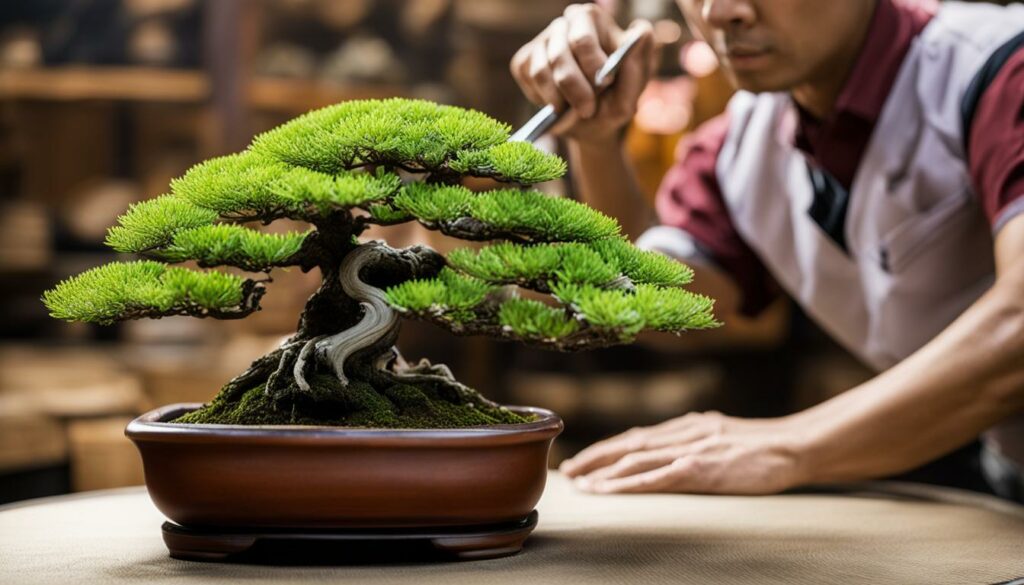
Root Styling Methods for Enhanced Bonsai Aesthetics
Root styling is an essential technique in creating a visually appealing bonsai. The roots of a bonsai tree should complement the overall design and balance of the tree. There are several root styling methods that you can use to create a unique, aesthetically pleasing look for your bonsai tree.
Exposed root style: This method involves training the roots of the bonsai to grow above soil level, creating a stunning and distinctive look. This style is commonly used for trees with a rugged or weathered appearance.
Nebari development: Nebari refers to the spreading of roots near the surface of the soil. This technique is often applied to bonsai trees in their development stage. It enhances the overall look of the tree and gives a sense of stability and height to the viewer.
Aerial root development: This style involves training roots to grow above ground or on hollow stumps or rocks. This unique technique can bring an authentic, natural look to your bonsai tree.
Twisted root style: This method is used to achieve a delicate and intricate look with roots that appear twisted and entwined with each other. This design is usually seen in trees with a delicate and elegance appearance.
Root styling requires careful attention and patience. Incorrectly manipulating the roots can damage the tree and impact its overall health. It’s important to carefully consider the styling method that best suits your bonsai tree’s unique characteristics and the overall look you are trying to achieve.
Air Layering for Bonsai Root Development
Air layering is a technique used in bonsai cultivation to encourage root development in specific areas of the tree. This method creates new roots on the plant while it is still attached, making it an effective way to repair or enhance the root structure of a bonsai tree.
To perform air layering, start by identifying the area of the tree where you want to encourage root growth. Use a sharp knife to peel away a section of bark about 1-2 inches long and remove the phloem layer underneath, leaving the cambium layer intact. Then, wrap the area with moist sphagnum moss and wrap it in plastic to keep it moist. Wait until roots begin to develop, then cut the branch below the new roots and pot it in well-draining soil.
Air layering is an ideal technique for bonsai trees with undesirable root structures, as it allows you to create new roots where they are needed most. You can also use this technique to propagate new trees from an existing specimen.
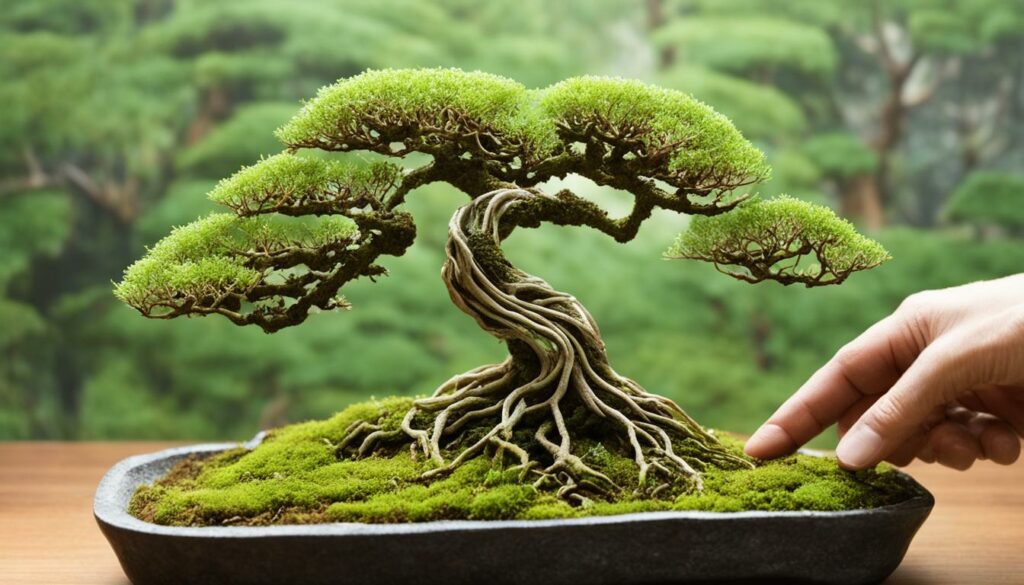
Root Raking and Soil Composition in Bonsai
In the art of bonsai cultivation, root raking is a common technique used to surface the roots of a tree and spread them outwards. By doing so, this technique allows for the roots to absorb nutrients more efficiently, leading to optimal growth and development.
The process involves carefully combing the roots of a tree with a fine-toothed comb or brush, which helps to remove any soil that may be compacted between the roots. When performing root raking, it’s important to handle the roots with care to avoid damaging them.
It is critical to remember the significance of soil composition in bonsai cultivation, as it directly affects root system health and growth. The ideal soil mixture for bonsai is one with good drainage, yet retains enough moisture and nutrients to sustain the tree.
Remember that soil quality is of utmost importance when it comes to bonsai root health. Poor soil composition can lead to root rot and other diseases, so being mindful of the soil mixture is crucial to maintaining a healthy root system.
A commonly used soil mixture for bonsai cultivation is Akadama soil, which is made of clay minerals extracts from volcanic soil. In addition, a common mixture, KETO is a blend of Akadama, Pumice, Lava rock that is often used for bonsai soil. It’s essential to research and adjust the soil composition based on the specific tree’s needs.
Watering and Fertilization for Robust Bonsai Roots
To maintain a healthy and vibrant bonsai root system, proper watering and fertilization are essential. The frequency and techniques you use depend on several factors, including the species of bonsai, pot size, and environmental conditions. Overwatering and underwatering your bonsai can lead to root rot or dehydration, which can damage or kill your miniature tree.
Watering:
The ideal watering frequency for bonsai is typically every two to seven days, depending on the type of bonsai and the weather conditions in your region. To test if your bonsai needs water, insert a chopstick or skewer into the soil. If it comes out dry, it’s time to water your bonsai. Make sure to water thoroughly until the water drains from the bottom of the pot to avoid waterlogging the roots.
Fertilization:
Bonsai require regular fertilization to provide the essential nutrients needed for healthy growth and root development. A balanced fertilizer high in nitrogen, phosphorus, and potassium is ideal. The frequency of fertilizer application depends on the type of bonsai and the stage of growth. Generally, fertilizer should be applied every two to four weeks during the growing season and every six to eight weeks during the resting season.
| Bonsai Type | Watering Guidelines | Fertilization Schedule |
|---|---|---|
| Mature Conifers | Every three to seven days during the growing season, every two to three weeks during the resting season | Twice per month during the growing season, once per month during the resting season |
| Mature Deciduous | Every two to five days during the growing season, once per week during the resting season | Twice per month during the growing season, once per month during the resting season |
| Young Bonsai | Every two to three days during the growing season, once per week during the resting season | Every two weeks during the growing season, every four weeks during the resting season |
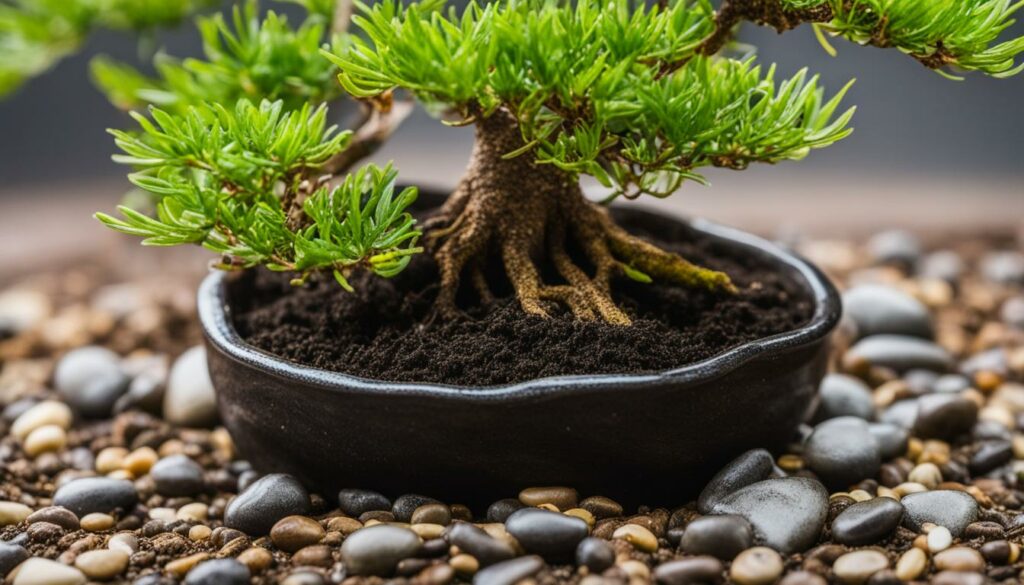
A common mistake beginners make is to over-fertilize their bonsai, leading to salt buildup in the soil and root damage. It’s essential to follow the instructions on the fertilizer package and avoid applying fertilizer when the bonsai is experiencing drought stress. Monitor your bonsai carefully and adjust the watering and fertilization practices accordingly to maintain optimal root health.
Repotting Bonsai: A Vital Step in Root Training
Repotting is a crucial step in bonsai root training and management. The process involves removing the tree from its current pot, trimming the roots, and placing it in a new pot with fresh soil.
Timing is key when it comes to repotting your bonsai. Typically, the best time to repot is during the early spring season before the tree begins to bud.
It’s important to select the right pot for your bonsai when repotting. The new pot should be slightly larger than the previous one, providing enough room for root expansion without being too big. A larger pot can lead to excessive moisture retention, which can harm the root system.
When repotting, carefully remove the tree from its current pot, gently remove old soil from the roots, and trim any dead or damaged roots. Using sharp scissors or pruning shears, be sure to make clean cuts and avoid tearing the roots.
After trimming, place the bonsai in the new pot with fresh soil, ensuring the tree is centered and at the same depth as before. Use a chopstick or similar tool to gently press soil around the roots, removing any air pockets.
Finally, give your bonsai tree a good watering, making sure the soil is thoroughly moistened.
Repotting your bonsai tree is essential to promote healthy root growth and overall tree health.
Maintaining a Healthy Bonsai Root System
After implementing root training techniques in your bonsai cultivation, ongoing maintenance is crucial for the health and vitality of the root system. Regular inspections of your bonsai’s root system can detect any issues before they worsen. Check the color, density, and distribution of the roots, and trim any dead or damaged roots immediately with sterile cutting tools.
Disease prevention is also essential in root care. Avoid overwatering your bonsai, as it can cause root rot, which can be fatal to your tree’s root system. Instead, provide adequate drainage and avoid allowing water to sit in the saucer for extended periods. Fungal growth can also harm your bonsai’s root system, so avoid using contaminated soil or replanting with improper sterilization techniques.
Extreme weather conditions can be stressful for your bonsai’s root system. Protect your tree’s roots from frost by adding an insulating layer of mulch around the base. In warmer weather, keep your bonsai protected from direct sunlight to avoid dehydration and excessive heat exposure.
Proper maintenance ensures the ongoing health and vigor of your bonsai’s root system, which directly impacts the overall well-being of your miniature tree.
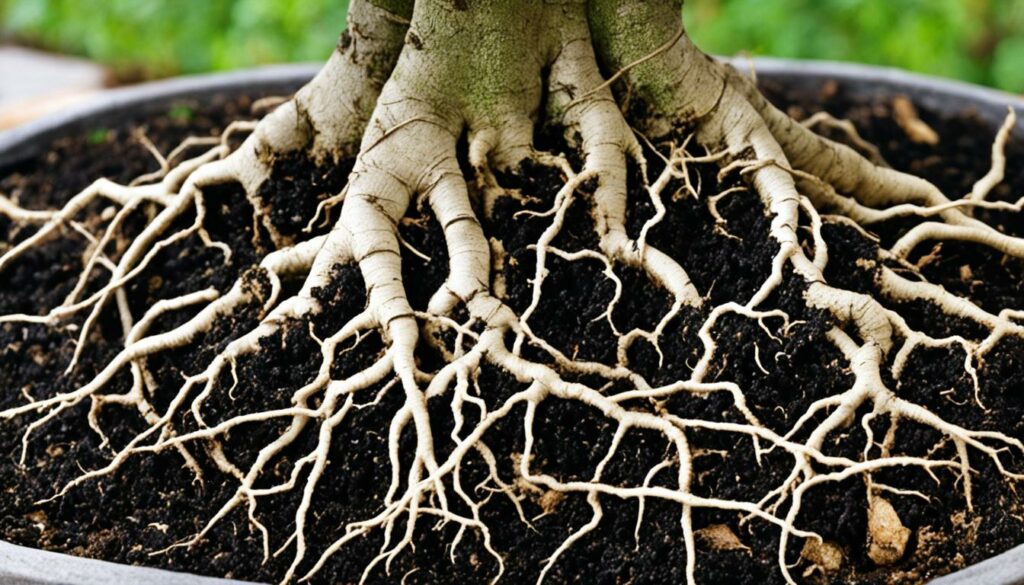
Summary
Incorporating root care techniques and ongoing maintenance practices are critical in cultivating a healthy bonsai root system. By regularly inspecting your tree’s root system, preventing disease, and protecting it from extreme weather conditions, you can ensure the continued vitality and longevity of your miniature tree.
Troubleshooting Common Root Issues in Bonsai
Despite your best efforts to maintain a healthy root system, problems may still arise in bonsai cultivation. Here we highlight the most common root issues, how to identify them and offer tips for resolution.
Root Rot
Root rot is a fungal infection that causes the roots to decay and turn brown or black. Overwatering, poor drainage or contaminated soil are common culprits for this issue. To prevent or treat root rot, avoid overwatering, improve drainage, remove affected roots and repot in fresh soil.
Poor Drainage
Insufficient drainage can lead to waterlogged soil and restrict root oxygen supply, leading to root decay or suffocation. Ensure the pot has drainage holes, check soil type and consistency and avoid packing soil too tightly.
Root-bound Conditions
Root-bound conditions occur when roots grow in circles, constricting themselves and decreasing the amount of soil available. This leads to nutrient deprivation and stunts growth. To avoid root-bound conditions, periodically repot your bonsai and prune roots that are circling or tangling together.
Dry Roots
Dry roots are problematic and can cause your bonsai tree to wilt, brown, and lose leaves. Underwatering, low humidity, or lack of proper soil components are common causes. Water your bonsai tree thoroughly and ensure its soil mixture incorporates soil components that improve water retention and aeration.
Conclusion
Congratulations! You have now learned crucial techniques for root training and management in bonsai cultivation. By focusing on the health and vigor of the root system, you can ensure the optimal growth and beauty of your miniature trees.
Remember, root care is essential to the overall well-being and longevity of your bonsai tree. Take time to evaluate the condition of your bonsai’s roots and select the right pot for optimal root growth. Utilize root pruning and styling techniques to enhance the aesthetics of your bonsai and consider air layering for specific areas of the tree.
Proper watering and fertilization practices, as well as repotting as needed, are crucial for maintaining healthy and robust bonsai roots. Ongoing inspections and preventative measures can help address common root issues that may arise.
By implementing these techniques and practices, you can maintain a healthy bonsai root system and ensure the continued vitality of your beloved miniature trees. Good luck with your bonsai cultivation journey!
FAQ
Why is root care important in bonsai cultivation?
Root care is crucial in bonsai cultivation as the health and stability of the root system directly impact the overall well-being and longevity of the tree. Proper root care ensures optimal growth and vitality in bonsai trees.
How can I evaluate the condition of my bonsai root system?
To assess the condition of your bonsai root system, examine factors such as root color, density, and distribution. Understanding the current state of your bonsai’s roots will guide your root training and management decisions.
What should I consider when selecting a bonsai pot for root growth?
When choosing a bonsai pot, consider factors such as adequate space for root expansion, proper drainage, and material compatibility. The right pot promotes healthy root growth and supports the overall health of the bonsai.
What are the techniques for root pruning in bonsai?
Root pruning involves selectively trimming the roots to maintain a balanced root-to-shoot ratio. Techniques include timing the pruning correctly and using appropriate tools to encourage the development of finer feeder roots and improve nutrient uptake.
How can I style the roots of my bonsai for enhanced aesthetics?
Various root styling techniques can be used to enhance the visual appeal of your bonsai. These techniques include shaping the exposed roots and developing nebari, which refers to the surface roots that add character and balance to the overall bonsai design.
What is air layering and how does it promote bonsai root development?
Air layering is a technique used to promote root development on specific areas of a bonsai tree. It involves creating a ring cut in the bark and encouraging the growth of roots in that specific section. This method is useful for improving root structures or propagating new trees.
What is root raking, and why is soil composition important in bonsai?
Root raking is a technique used to expose and spread the surface roots in bonsai. This method enhances the tree’s nebari and overall aesthetic appeal. Additionally, the composition of the soil is vital for optimal root health and growth in bonsai trees.
What are the best practices for watering and fertilization of bonsai trees?
Proper watering and fertilization are essential for robust bonsai roots. It is important to understand the ideal watering frequency, techniques, and nutrient requirements for your specific type of bonsai tree. Consistency and balance are key to maintaining healthy root systems.
When and how should I repot my bonsai tree for root training?
Repotting is a vital step in root training as it allows for root maintenance and growth. The ideal time to repot depends on the tree species, but generally, it should be done every 1-3 years. Repotting involves carefully removing the tree from its old pot, pruning the roots, and placing it in fresh bonsai soil.
What ongoing practices should I follow to maintain a healthy bonsai root system?
Regular inspections, disease prevention, and protection during extreme weather conditions are crucial for maintaining a healthy bonsai root system. Additionally, ensuring proper watering, fertilization, and timely repotting contribute to the continued vitality of your bonsai tree.
How can I troubleshoot common root issues in bonsai?
Common root issues in bonsai include root rot, poor drainage, and root-bound conditions. It’s important to identify these problems early and take appropriate measures to resolve them, such as improving drainage, adjusting watering practices, or performing root treatments.
